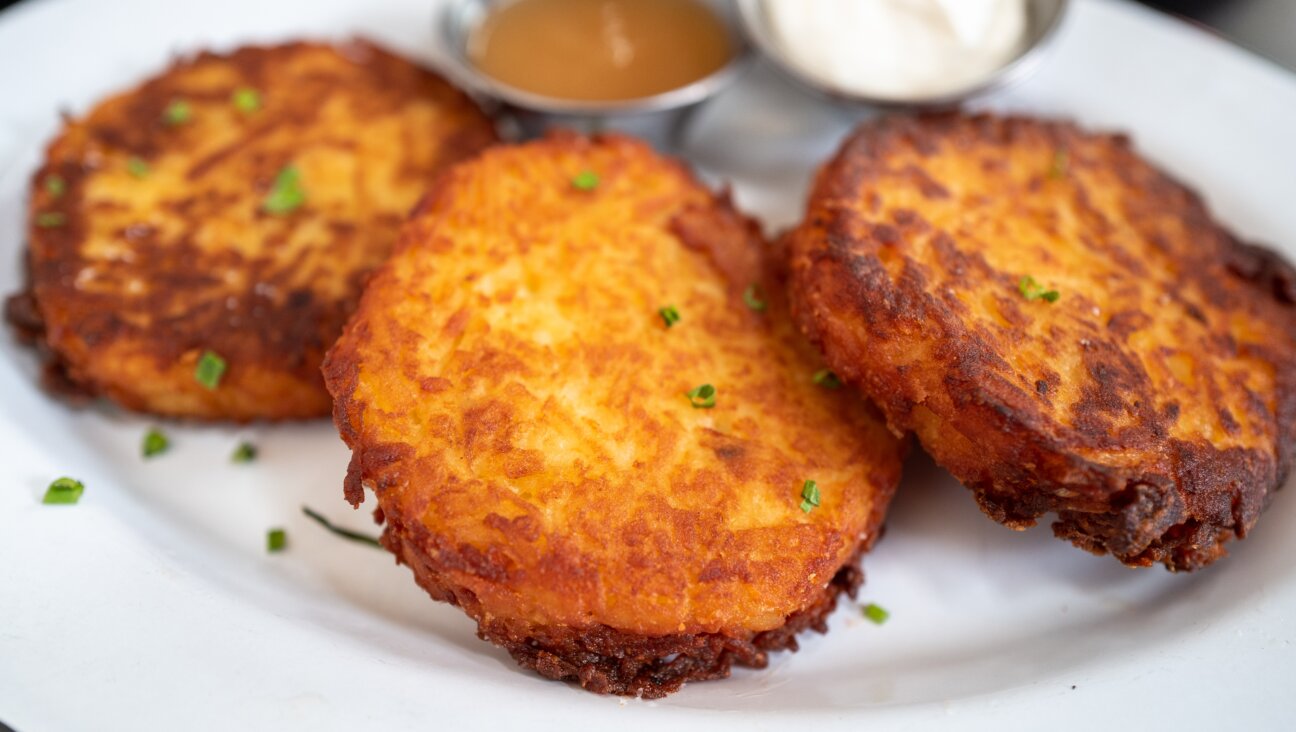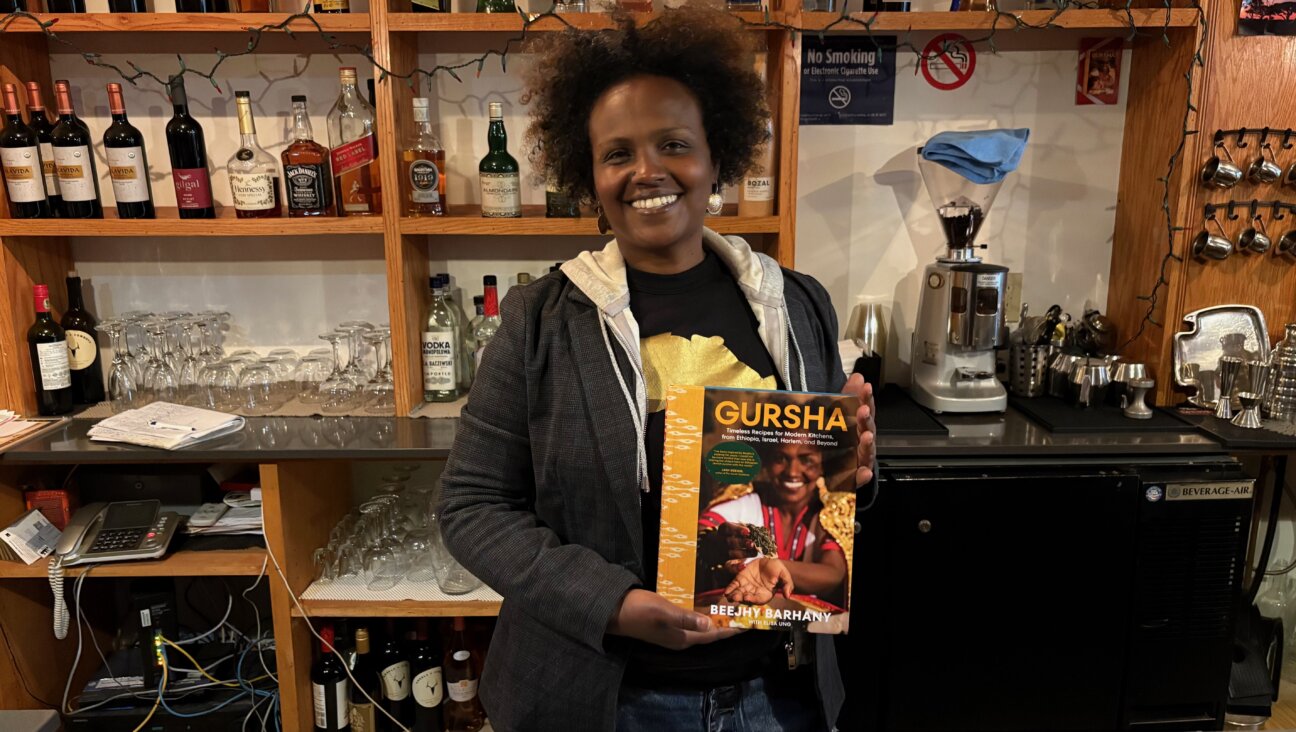Haimish to Haute in New York

Graphic by Angelie Zaslavsky

Kutsher?s Goes Downtown: The stylish take on Jewish classics is reflected in the new restaurant?s deli charcuterie platter. Image by evan sung
Matzo ball soup at Nolita’s most au courant café? Kreplach at Tribeca’s latest New York Times-reviewed eatery? Kasha varnishkes by iconic New York chef Jean-Georges Vongerichten in Union Square? You can stop rubbing your eyes: Jewish food is indeed having its New York makeover moment.
After years of watching other iconic immigrant cuisines burnished for a new generation (and even seeing Mediterranean-Israeli food beat them to the punch at places like Einat Admony’s Balaboosta), a group of young chefs, restaurateurs and food lovers are transforming traditional Jewish dishes into fare aimed to please modern palates of all persuasions.
Is the ascendance of haute-haimish grub a mere flash in the frying pan, or is there something deeper at play? Some are calling it an ephemeral trendlette, while others divine a deeper social significance, suggesting that the driving force is a desire to connect with the past in a meaningful way. One thing’s for certain: No matter where you fall in this debate, gefilte fish will never be the same again.
“It’s our most controversial menu item,” said Zach Kutsher of the version he offers at Kutsher’s Tribeca, the downtown restaurant inspired by his family’s legendary Borscht Belt resort of the same name. In the hands of chef Mark Spangenthal, the jarred, pike-in-gel specimen familiar to most American Jews has been reimagined as diced wild halibut bound with carrot and onion, shaped into small discs that the chef wraps in parchment paper and gently poaches in house-made fish stock. Served with a delicate beet-and-horseradish tartare, it’s a menu standout that represents the interplay of nostalgia and heightened culinary standards.
“Gefilte fish and quenelles (broth-simmered French dumplings) have met, and they seem to like each other,” said Clark Wolf, a restaurant consultant who has been tracking industry trends for 30 years. “For one thing, with all due respect to my ancestors, any of these chefs is a better cook than my bubbe.”
Often, the revamped Jewish comfort foods reclaim techniques that skipped a generation or two as aspirational children of immigrants lost connection to the hard-work foodways of their ancestors. At Kutsher’s, the kreplach and knish doughs are house-made, as are the duck pastrami, beef tongue and chopped liver (capped with a crunchy sliver of gribenes) on the kosher-style charcuterie platter. In the East Village, Zucker Bakery owner Zohar Zohar, who spent years working in traditional French kitchens for renowned chefs including Daniel Boulud and David Bouley, is baking Fridays-only challah and yeast-risen babka influenced by her grandmother’s recipes.
Also in the East Village, at JoeDoe, Joe Dobias and his longtime girlfriend, Jill Schulster, have been serving “aggressive American” food, some with a decidedly Jewish pedigree, for nearly four years. To impress Shulster’s Jewish parents, the Irish-American Dobias began curing briskets. Now his menus include dishes like matzo brei with cilantro and spicy honey, as well as knaidlach nesting in a tomato-tomatillo sauce. Around the corner at JoeDough, their new sandwich shop, one of the most popular offerings is The Conflicted Jew, a chicken liver, onion and bacon sandwich on house-made challah.
Even award-winning greenmarket-centric restaurant, ABC Kitchen, is getting in on the game. Before it opened in 2010, chef/owner Jean-Georges Vongerichten tasked executive chef Dan Kluger with updating a dish he’d once sampled: kasha varnishkes. The new version cushions tender veal meatballs atop house-made egg noodles, punctuated with the surprising pop of toasted buckwheat grains. It’s now a signature dish that Kluger concedes will be hard to remove from the menu.
Opening the restaurant called Jack’s Wife Freda gave husband-and-wife owners Dean and Maya Jankelowitz the opportunity to translate their South African (his) and Israeli (hers) Ashkenazi Jewish heritage for the skinny-jeans set — to wit: fish again, this time croquettes made with the smoked whitefish more ordinarily found on an appetizing platter, here enrobed in panko, then fried to a shattering crispness; luscious matzo balls enriched with duck fat and floating on a resplendent mahogany broth, and crispy chicken giblets brightened with mildly spicy pirri pirri sauce.

Not Grandma?s Gefilte: The gefilte fish at Kutsher?s has been reimagined as finely diced poached halibut. Image by evan sung
“In the end we all go back to the foods of our childhood,” said Jankelowitz. “I love Katz’s as much as the next guy, but the food needed a twist.”
Noah Bernamoff agrees. At his Brooklyn deli and restaurant, Mile End, Bernamoff gained recognition for his sandwiches. When he looked to expand to dinner service, he tried out the original, one-pot versions of deli standards like roast chicken and sweetbreads, then analyzed and tweaked. “You’ve got to be critical, too,” said Bernamoff. The result is dishes like tender stuffed cabbage featuring lamb, barley and a mint-and-pistachio pesto in lieu of the usual beef and rice.
Still, there are limits to innovation. Though Bernamoff himself is neither religious nor kosher, “…we’re not going to wrap bacon around a matzo ball,” he said.
Jewish culture expert and Forward columnist Jenna Weisman Joselit sees the return to schmaltz as an expression of the current ’60s zeitgeist expressed in shows like “Mad Men.” “It’s almost a faux nostalgia for something they never experienced in the first place,” said Joselit, who also cites a desire of a younger generation to express Jewish identity without committing to religious practice. Call it, if you will, shedding the yoke in favor of the yolk.
Sometimes, the trend has a slow-food feel. On a Sunday night in early March, Brooklyn’s young fooderati gathered to celebrate a new business-cum-movement, the Gefilteria, which seeks to recreate a “carp-in-the-bathtub” aesthetic of times gone by. In a packed room they sipped brilliant pink, ginger-and-vodka spiked kvass, a sort of fermented-beet kombucha, as they nibbled on sauerkraut, black-and-white cookie sticks and gefilte fish made with whitefish, salmon and pike sourced from sustainable purveyor Wild Edibles. The three founders, all in their 20s, are planning a roving pushcart to peddle their wares at hipster-haven food fairs like the Brooklyn Flea and Smorgasburg.
Tapas entrepreneur Alex Raij (Tia Pol, Txikito, El Quinto Pino) is using her soon-to-open Brooklyn venture, La Vara, to explore the intersection of cultures that defined Moorish food: Jewish, Muslim and Christian. “I can easily see where the Jews and Moors left a distinct imprint on Spanish cuisine,” said Raij, whose menu will include the chickpea stew cocido, one of Spain’s national dishes that can trace its roots back to long-cooking hamin, or Sabbath stew — though Raij’s version will omit both the traditional Sephardic hard-boiled eggs and the pork products found today in most Spanish versions.
Like most of the new crop of chefs and foodies, Raij is embracing an unapologetic instinct to blend the humble Jewish roots of times gone by into very current ventures. “For the younger generations of cooks and eaters, it’s no longer about fitting in or grabbing the brass ring,” said restaurant consultant Wolf.
“We’re embracing our heritage but in a way my generation can relate to,” added Gefilteria co-founder Jeffrey Yoskowitz. “Bring back the schav!”
Adeena Sussman is the restaurant critic for Manhattan magazine. Her writing has appeared in Food and Wine, Gourmet, Fodors, Sunset and Hadassah.
View Jewish Food in NYC in a larger map

















